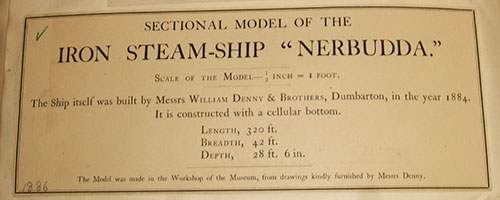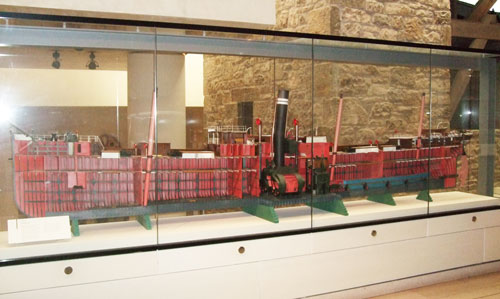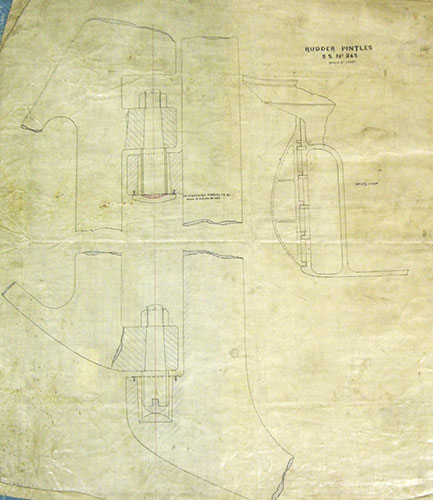Working in the Science and Technology department over the years I’ve come across a number of impressive and inspiring objects. One such object that has always grabbed my attention is the model of S.S. Nerbudda. I remember on one particular day strolling through the National Museum of Scotland carrying out my weekly rounds of dusting objects, when I spied this magnificent item. It was then I felt I would like to know more about the history of this object.

S.S. Nerbudda can be seen displayed in the Workshop of the World gallery. It is a large model at 4.2 metres in length. Built in the Museum’s model workshop in 1885, the model was described as ‘innovative’, since it was unique in size and presentation.

“The model, which is on the large scale of half an inch to the foot, is sectional, and shows construction, fittings, and machinery of the ship in the minutest detail, in a manner probably never before attempted.” The Museum’s Annual Report 1885.

The model itself was built from the original ship plans used and provided by the firm William Denny & Brothers Ltd, Leven Shipyard, Dumbarton. I decided to take a closer look at these plans, which are now in storage. Having worked in the past on a documentation project on engineering drawings and plans, I found this enabled me to get a good understanding of the detail that went into the planning and building of the model. Every part was thought about, right down to the finest detail – although the pink colour of the propeller has never been explained! Traditionally propellers were metal, so the very fact that this part was painted pink is somewhat of a mystery.
History of the ship
Researching the historical background of the ship, I discovered that the S.S. Nerbudda was a cargo ship, built for the British India Steam Navigation Company Ltd, Glasgow, in 1882. It also served as a passenger ship, with accommodation for 32 First Class passengers and 15 Second Class passengers.

Nerbudda remained in service with British India until 1911, when it was sold to the company Sato Shokai Goshi Kaisha, who renamed it the Asuta Maru. Exactly why the Museum decided to create a large scale model of the Nerbudda is not clear. The ship itself was not a piece of ground-breaking engineering. Steam ships had been in operation since the early 1800s. Nonetheless, an excerpt from The Scotsman reported that the model would attract great interest from the public.
“We have no doubt that this elaborate and instructive piece will prove of the highest interest, not only to the general public, but to serious students of marine architecture and engineering.” The Scotsman, 31st December 1885.
Museum model-making
The Nerbudda model is a prime example of the detailed and skilled work that was carried out by the Museum model workshop, which built a wide array of working technological and science models from the late 1860s to the mid-1970s. Detail and accuracy were of paramount importance to the Museum model makers, their reasoning being the Museum’s ethos: to enable its audience to see up close the technological and scientific innovations created in industrial Britain. The models allowed the Museum to do this, in a way that was accessible and easy to understand for visitors. Here a quote from a letter written by Thomas Archer, the Director of the Museum from 1860-1884, illustrates the high level of accuracy required in the building of Museum models:
“I have now got the model of the S.S. “Nerbudda” so far advanced that the workmen cannot safely proceed much further without seeing some of the detail of the finishing of the decks and other portions on an actual ship, something similar to the vessel that the model represents. From the large size of the model (14 feet long) any important error will be very conspicuous. I propose accordingly, to send through to Dumbarton the two model makers who are doing the iron work, and the joiner who is doing the wood work of the model, to get some little information about these details…” Thomas Archer (Museum Director) to Messrs W. Denny & Bros, Leven Shipyard, Dumbarton, 8 Sept 1884 (National Museums Scotland Library Archive, Directors’ Correspondence – General, Letterbook 1881-1887, p. 140).
Today you can still see some of the models displayed throughout the Museum. The Museum no longer produces models but those that were previously made are maintained and now cared for by the Museum’s engineering conservation team. The history of the Museum and its workshops is currently a subject which is being revived through the research of Research Associate Geoff Swinney. Together with Dr Klaus Staubermann, Principal Curator at the Science and Technology department, Geoff has uncovered many interesting facts about the history of the Museum’s model-making practices, which can be traced back to 1868. Further to this work, the Museum plans to showcase more of the models in future exhibitions. Some of these models will be available to see in the new Science and Technology galleries, which are scheduled to open in 2016.
